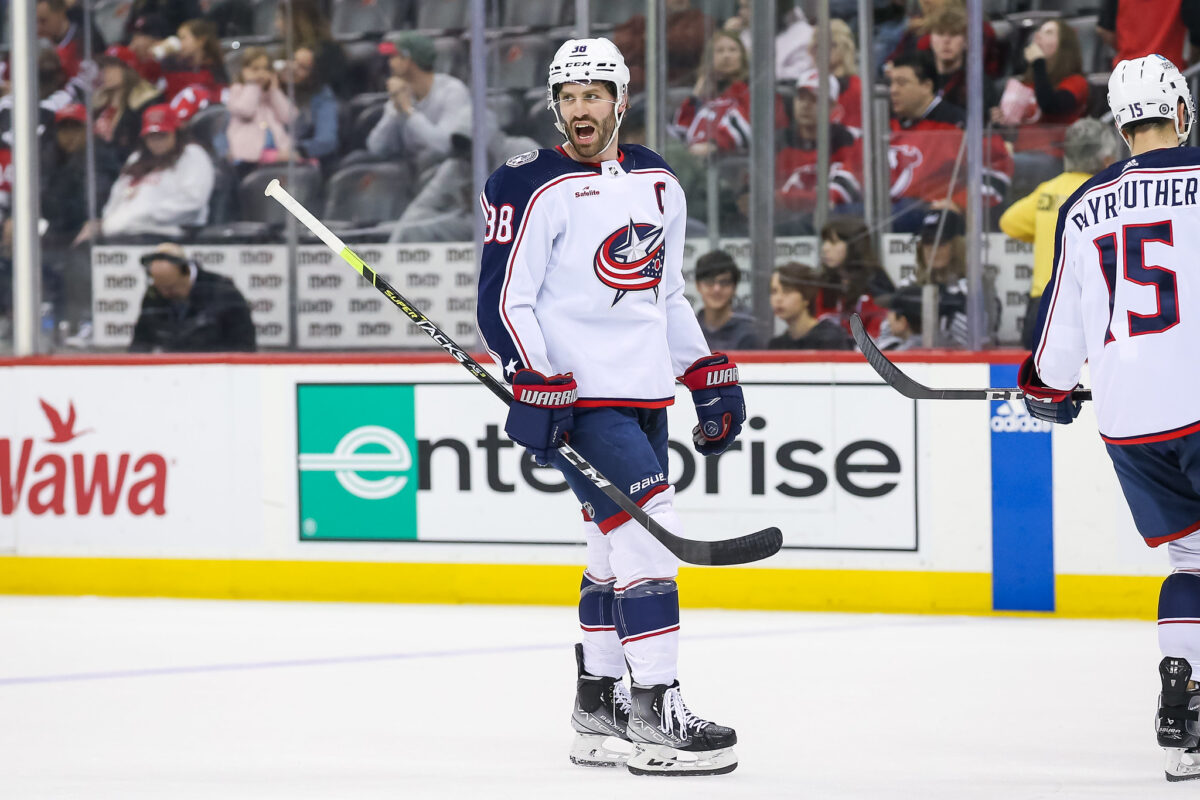The Columbus Blue Jackets have a problem: too many players under contract. As it stands they have 13 or 14 defensemen and 16 or 17 forwards that could spend time at the NHL level this season. Something has to give. Someone needs to be traded out to make space for the incoming wealth of young talent.
When looking at the forward corps, there are a few options on expiring contracts that could be traded away sooner, like Jack Roslovic and Eric Robinson, but those depth pieces would net less than a haul on the open market. Who are some Blue Jackets that could be traded and actually bring back a substantial amount of assets to reinvest in the club?
The list is short, but right at the top is the longest-tenured Blue Jacket and team captain, Boone Jenner. He’s a two-way force who is good for around 25 goals a season and can lead the top penalty-kill unit. He’s a physical player, with over 100 hits every season that he’s played over 60 games, and is sublime in the faceoff dot, with a 54-percent win rate through his career. He checks a lot of boxes for an aspiring championship contender and may be on the Blue Jackets’ trade block. Let’s dive in.
Jenner Doesn’t Project Well for the Blue Jackets
This could definitely be an unpopular take, but Jenner does not project well with the Blue Jackets. While he’s only 30 years old now, you have to look ahead to when the team will be a legitimate Stanley Cup contender. Realistically and considering the other teams in their division and conference, the team is at least three to five years away from a legitimate push for the Cup.

In three to five years, Jenner will be 33 to 35. I understand that being in your mid-30s is not the kiss of death that it once might have been in the NHL, but there are only 88 players over 33 years old signed to a big league contract for this season. Of those, only 49 are forwards and only 19 scored more than 35 points last season. The odds against Jenner still being a two-way force (offense is part of two-way) by the time the Blue Jackets open their Stanley Cup window are pretty high.
Then the organization has to factor in his injury situation. He’s lost 37 games over the last two years and hasn’t played a full season since 2016-17. There’s a good chance that by the time he’s 33 to 35 that the toll his physical style of play takes on his body will have mounted up and he will decline significantly. To be frank, when the Blue Jackets will be trending up, Jenner will be trending down. It makes sense to trade him now, while he has value and a chance to play a bigger part in another city’s run to a Stanley Cup.
Jenner’s Contract is a Unicorn
Here’s the thing: when Jenner signed his current contract, it was after several seasons of him settled in as an average middle-six, defensive-first winger. We always knew he had the ability to pop-off offensively, as showcased in 2015-16 when he scored 30 goals, but it looked like he had become comfortable being a reliable depth piece. So he signed his four-year contract extension, making the exact same amount of money as the four years before that — $3.75 million.

Then the Blue Jackets put the captain’s “C” on his chest and everything changed. The trade of Pierre-Luc Dubois opened up a gaping hole in the middle of the team’s top line and Jenner was quick to claim his territory. So, the Jackets have had their first-line center for less than $4 million per season. That’s absolutely ridiculous. If he were traded to a contender, he would be more suitably slotted in as a second- or third-line center. There is still tremendous value in his contract while lower on the depth chart, considering all that he brings to the table.
Related: Ranking Columbus Blue Jackets Contracts for 2023-24
He’s been good for around 25 goals and 45 points each of the last two seasons. If he had been injury free, he was on pace for 31 goals and 55-60 points in each of those seasons. Those stats alone project him to earn roughly $5.5 to $6 million per season, and that’s without taking into account his leadership and strong defensive play. Then, factor in the term of the deal and realize a contender would be getting those cap savings for the next three years. Not too shabby.
The Return for Jenner Could Be Great
Championships are won through depth and salary cap efficiency. Depth at the center-ice position is particularly valuable. So, let’s look back at a few trades for depth forwards on championship squads over the last few years. There are none that exactly fit the bill, so we’ll look at a few different similar scenarios as best-case scenarios.
Exhibit A: Barclay Goodrow was acquired by the Tampa Bay Lightning. Goodrow has much less offensive ability than Jenner, but the comparison here is term. While this move was considered an overpay at the time, it might have opened the door for more trades on depth players with years remaining on their contracts. The eventual champions surrendered a first-round pick and prospect Anthony Greco in exchange for Goodrow and a third-round pick. He was a key depth piece in two Stanley Cup runs on a low-priced contract, before his contract expired and he found a new home.

Exhibit B: Nick Foligno traded to the Toronto Maple Leafs. This has a combination of factors, including Blue Jackets’ management and similarity of player, since Jenner was formed in the Nick Foligno mold. What did a solid two-way player who also happened to be captain of Ohio’s team net at the 2020 Trade Deadline? A first-round and a fourth-round pick. That was only for one playoff run and Foligno had already been trending downwards as a 33-year-old. You’d have to imagine Jenner could pull in more than that.
Exhibit C: Andrew Copp dealt to the New York Rangers. Copp is as close to Jenner as any player traded recently. The main difference is Copp’s age, as he was only 27 when he was traded. The Jets’ two-way, middle-six center, who played in about 50-60 games a season and scored 30-35 points, brought back a haul. He was only a rental, but he was worth a B-level prospect in Morgan Barron, along with a first-round, second-round, and a fifth-round pick.
While these are just a few best-case scenarios, it’s proof that it would not be out of the realm of possibility for the Blue Jackets to expect a return, including a first-round draft pick plus other assets, as a blue book value for their captain.
Jenner finds himself at the intersection of high market value, aging ahead of the Blue Jackets’ core, and having a very solid contract with term. That without a doubt makes him the most valuable potential trade chip. Now, the real question is, and we’ll save it for another day: Should they trade him?

